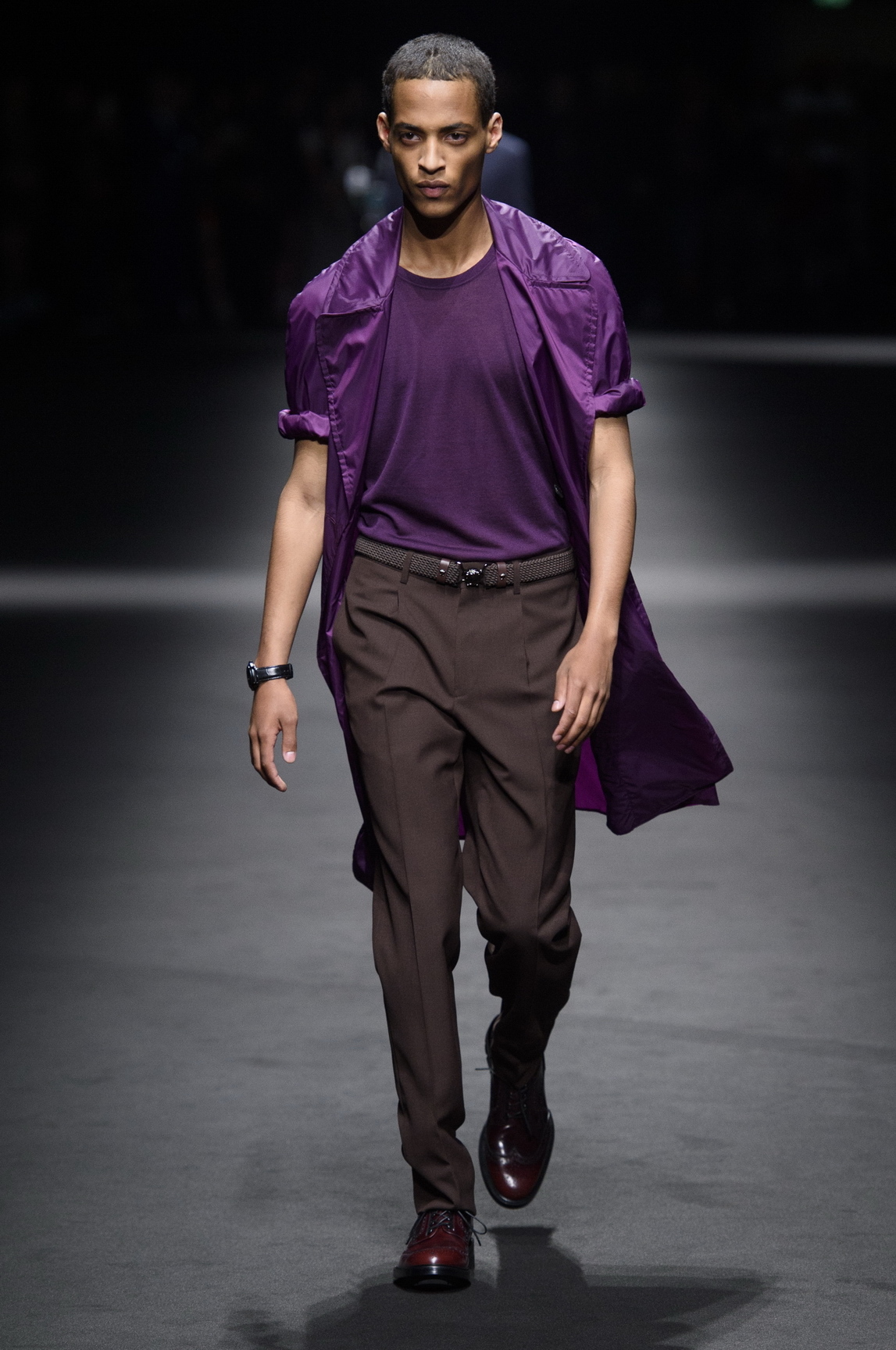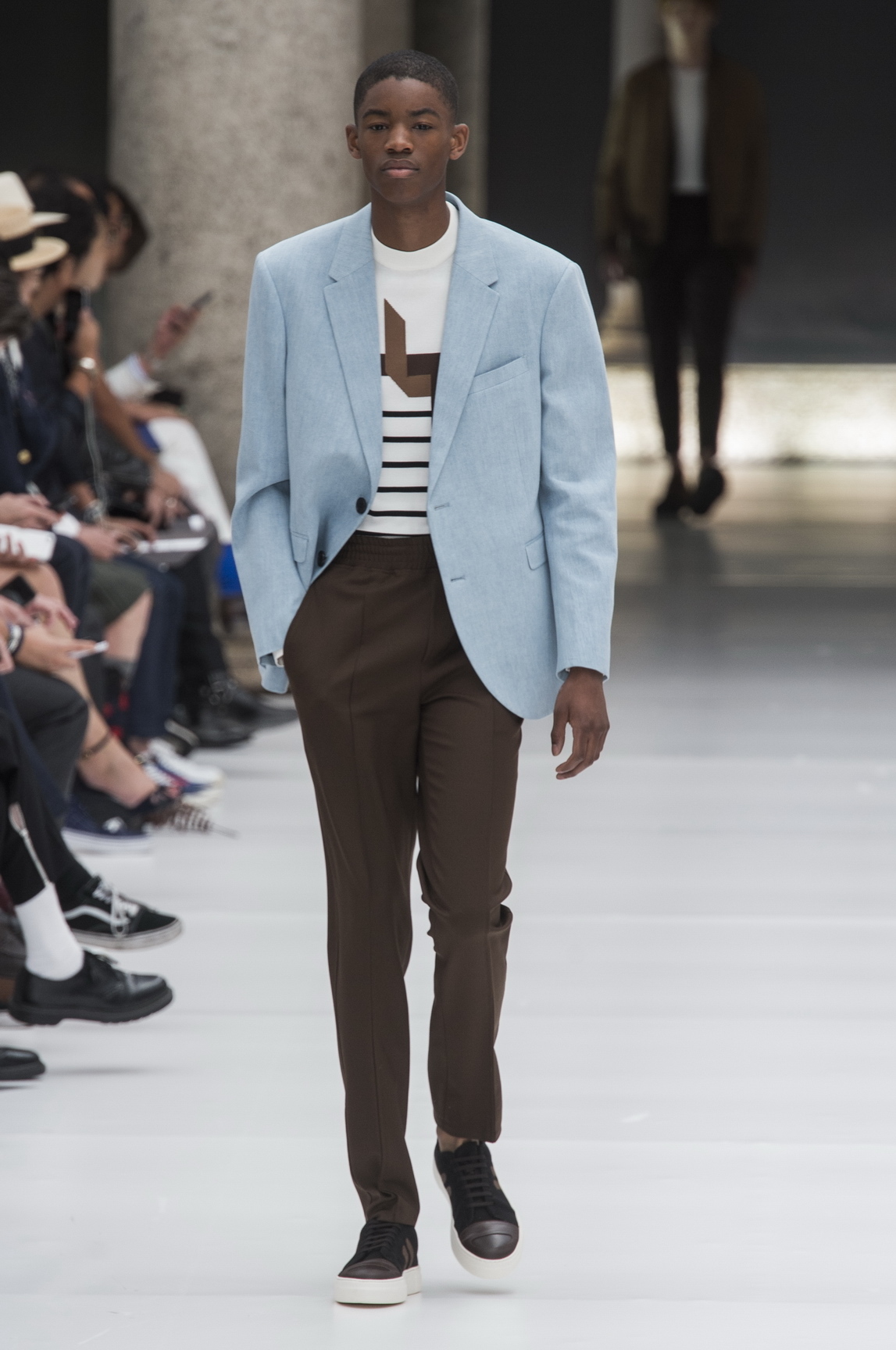There’s something different in the air this season at the men’s shows. The number of shows in London was down by some thirty percent. There was no Alexander McQueen show (due to Sarah Burton’s maternity leave), no Burberry show (the brand is showing men’s with women’s come September), no specially tailored events by Paul Smith or Jimmy Choo, and no James Long show. Here in Milan, it’s the same story: the Iceberg collection James Long debuted last season to rave reviews is nowhere to be seen, Peter Dundas isn’t following up his amazing first men’s show for Roberto Cavalli with one this season, Bottega Veneta is showing men’s with women’s in September and only doing appointments this weekend, Alessandro Sartori isn’t putting on a show for Ermenegildo Zegna, and Calvin Klein — currently designer-less until rumor has it Raf Simons will arrive — is only hosting a presentation. This season sees Gucci’s last show on the men’s schedule before merging its collections into the women’s show in February. It’s strange, though — for the past three seasons all we talked about is how exciting Milan had suddenly become after years of, well, not, and a lot of it had to do with those new designers: Alessandro Michele at Gucci, Peter Dundas at Roberto Cavalli, James Long at Iceberg.

It’s not that we’re short on big guns. Prada, Dolce & Gabbana, Fendi, and Armani are staying put for now, and on Saturday afternoon Donatella Versace went all out with a gigantic production in homage to her late friend Prince, which included a Bruce Weber film screening and show choreography worthy of a Tony award. The collection fused the trademarks of Prince — the purple, the skinny, the ruffle — with Versace’s current fling with techy sportswear, and Donatella looked magnificent in a suit featuring all of those components. It was the first of three shows on Saturday that represented a striking contrast to everything that’s going on in the men’s corner of the fashion industry. The show was mega, not just as a tribute but because it was physically huge, like the size of a Cirque de Soleil performance — big screens and dancing in tow. The same went for Pal Zileri, who took out another of Milan’s hangar-like spaces for its giant show, and — not surprisingly — for Philipp Plein, who likes to things to be big and had built an entire basketball court to which he’d invited the Harlem Globetrotters, a group of cheerleaders, and Busta Rhymes to perform pre-show. Oh, and the confetti canons!

On Monday, Plein is launching his new venture, Billionaire Couture, reminding us that Milan is still where the money is—and that there are still areas to be explored in menswear. (Brioni, another show missing from this season’s Milan schedule, will show at the haute couture week in Paris this July under the direction of its new designer, Justin O’Shea.) Take one look at Neil Barrett’s revenue for the past year and you’ll see there’s no reason to fear for the future of menswear. His show in Milan, which always takes place at the neo-classicist Palazzo del Senato, remains a trusty rock on the menswear schedule. On Saturday, he continued last season’s discovery of his childhood and youth. “I started in the winter, and taking it on into summer I wanted to go over my other formative years — the 70s going into 80s and 90s — and especially the American TV programs I used to watch as a kid, you know, Starsky & Hutch and Dukes of Hazzard or even Knight Rider, which I used as soundtracks. It’s taking something that is vintage and reinventing it and reinterpreting it and never reviving it, because it’s really important that it becomes something modern and current for today.” His words could have been the slogan for the future of menswear.

To say the atmosphere in Milan felt flat on the first day of shows would go against aforementioned descriptions — and those shows were definitely epic in the production department — but it seems the men’s fashion weeks are going through a rough-patch, not really trusting their own influence and worth. If Gucci and Burberry and Bottega Veneta can just fold their men’s collections into their women’s shows, what’s the point of even having a men’s fashion week? The question is rhetorical, and nothing could be further from the truth. Regardless of how gender-fluid the world is becoming, men and women won’t stop being men and women and while we should all wear each other’s clothes like there’s no tomorrow there’s still a lot to be said about the evolution of masculinity by the designers of the fashion world. After all, men’s fashion shows have played an invaluable role in the changed views of masculinity over the past three decades. It’s a job well done, but not a job completed. Adding to that, the men’s shows — which, for the spring/summer collections, take place months before the women’s fashion weeks — often serve to inform and inspire what happens in womenswear, and it’s a time cycle that could potentially be dangerous to mess with.

It might be the case at Gucci and Burberry, but as we were reminded on the Saturday of shows in Milan, at houses like Versace there’s no denying how important it is to have a separate platform for the male image of the brand. Donatella’s man and woman aren’t siblings or each other’s counterparts. They’re lovers. And in that transition there’s a whole set of energies that should never be presented in one big co-ed show, because the different sexual vibes of these creatures need their own platform in order not to simply blend in with the other side. In other words, it wouldn’t be very sexy — and although Donatella did throw a few women’s looks into the mix on Saturday, the majority of the show was still men. As we now know, things can change over-season in fashion and come January the men’s schedule might be back on track. If it’s not, however, the men’s department of the industry needs to figure out how to preserve itself, be it with trips like the women’s cruise collections where the show is presented in some faraway location for added exposure and publicity, by somehow sharing the women’s schedule so designers who don’t want to merge their men’s and women’s shows (if they even have both) still have a chance of putting on a standalone presentation, or via an entirely different route. But by all means, when it comes to menswear the shows must go on.

Credits
Text Anders Christian Madsen
